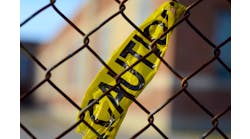Crimes against students have increased in the last decade — in schools during the school day, as well as to and from school. Federal statistics show that the increase is occurring across all populations — urban, suburban and rural — regardless of household income or ethnicity.
The threat of crimes can cause apprehension among students and put stress on the learning process. Establishing a secure environment for children to learn requires a continuing effort from all those involved in schools. Educators, law enforcement and community members need an overall plan for school security that emphasizes four key steps: deterrence, detection, delay and recovery.
Creating a climate
-
Deterrence
The first step in crime prevention is to deter the possibility of crime — or at least make it difficult for someone to feel comfortable committing a crime. This often involves modifying a school's culture or values. Understanding that risks exist can lead schools to develop a philosophy about school security. This brings people's concerns into the open and gives them a forum to make known any possible security breaches.
In most districts, the security of all school facilities is the ultimate responsibility of the superintendent. A superintendent might delegate that responsibility, but should stay involved. A district also should form a security committee that meets regularly to discuss concerns about school security. The committee should include representatives from every facility. In addition, individual buildings may have their own security committees.
A security committee should develop a security plan that keeps track of existing procedures and systems as well as ways to improve the security. Don't put the plan on a shelf after it is written — it should be a living document that is reviewed and revised continually.
-
Detection
Criminals are persistent and can find new ways to commit crimes. School security systems need to be able to detect when something potentially troublesome has taken place.
For instance, requiring all known persons to display an ID badge will make someone without a badge seem out of place. This could prevent a non-custodial parent from taking a child without permission.
More sophisticated methods may include electronic intrusion detection, access control or CCTV surveillance. The risk associated with unauthorized access will determine the required level of access control. Such a system can involve a simple number code, a card reader or a biometrics reader.
Another potential problem is people entering schools with weapons or drugs stored in backpacks or hidden in their clothes. To prevent this, many schools have prohibited students from using backpacks. Some schools have installed X-ray machines and metal detectors to find contraband.
Sirens and alarm systems can draw unwanted attention to a criminal, but by themselves may not be enough to stop a crime.
Electronic systems cannot read body language or interpret the unusual behaviors of a person trying to commit a crime. Therefore, many schools have school resource officers (SROs) on their campuses to deter crime.
-
Delay
Delaying a criminal may give law enforcement the additional time needed to catch someone in the act and keep the school and its students out of harm's way. A perimeter fence or vandal-resistant glass on a building can be the difference between catching a criminal or not. Multiple barriers will increase the delay. Envision a box in a box in a box; once the first box (a fence) is breached, the second box (building perimeter) needs to be entered. The third layer might be the locked door of the administration office.
-
Recovery
If a crime does occur, a school must be able to recover and continue its mission: teaching children. If a school is the target of arson, the displaced students need to have a place to report and learn until their classroom is repaired. After a theft, a school needs to replace the equipment that has been stolen.
Potential pitfalls
No security system is foolproof. Here's how to address some problems that may arise with school security systems:
-
Access control
Criminals all too often enter a facility with a lost or stolen ID. When employees leave their jobs, they must return their security cards. But in some cases, identification codes are stolen, and no one knows until items turn up missing or something worse happens.
Sometimes, employees use their ID card properly, but hold the door for another person who may not be authorized to enter the school — this is called tailgating. Propping open doors that don't have card readers also can create a dangerous security breach.
Criminals can damage a door, or place tape on it to keep it from closing properly. School employees should check doors daily and have damage repaired immediately. Fences and gates should be repaired to eliminate an easy entrance in an unauthorized area.
-
Faulty detection
Often, employees don't activate the alarm system, don't know how to operate it, or the system is broken. Don't ignore frequent false alarms. They often are a symptom of a problem with the system. Schools should have a skilled technician look into the problem.
-
Poor camera placement
Schools often install cameras in areas that make them easy targets for damage. Exposed cables or low-hanging housings can easily be broken, or rendered inoperable with paint or tape. Schools should maintain a system to ensure that lenses are focused and clean. If tapes are part of the system, they should be replaced after being used 10 times. Make sure that adequate lighting is provided so cameras will function properly at night.
The mistake that many schools make is assuming that someone will be monitoring the cameras at all times. A study by the U.S. Air Force found that a skilled security person can effectively monitor a camera feed for only 11 minutes each hour. Therefore, recording and playing back an event may be the only way to see what happened.
-
Metal detectors
Metal detection can be slow, as most air travelers can attest. The backups may create stress on the operator, who may not be as careful when trying to get students or visitors into the school.
The big tradeoff
Sacrificing security for convenience often is a big tradeoff on which criminals capitalize.
For instance, some staff members may feel they don't need to follow the rules because “everyone knows me.” If this is allowed, it leads to unequal enforcement of security policies and may cause other people to disrespect the system. Others may believe that because they are not going to do bad things, they don't have to follow the rules that are meant to stop criminals.
Some people may feel that disregarding a minor security rule will have no effect on overall security. But over time, the frequency of these transgressions may increase, and a criminal watching will exploit the opportunity to enter the school. Another commonly expressed attitude is that the business of a school is to teach, not incarcerate. This may cause security systems in many school districts to fail.
What can we do?
The cost of the systems and procedures can cause much discussion at school board meetings. Providing a completely safe facility with no risk of crime or violence would not make a school very conducive to learning. How much is enough for your school district? This is a tough question, and each community must sort through the many political and philosophical beliefs and perceptions that people hold.
School officials should find a capable firm to assess the vulnerability of each specific facility. A threat assessment normally would include: crime statistics, history, the local culture and environment, and changes in demographics. School executives, facility managers and teachers play an important role in identifying possible risks, and should be involved in a threat assessment.
NOTABLE
A popular tool to create a safe school environment is called Crime Prevention Through Environmental Design (CPTED). CPTED has four overlapping strategies to provide an environment that fosters learning while not feeling like a prison:
▪ NATURAL SURVEILLANCE
▪ TERRITORIAL REINFORCEMENT
▪ NATURAL ACCESS CONTROL
▪ TARGET HARDENING
Lupinacci, RCDD/LAN specialist, is senior telecom/security designer for Brinjac Engineering, Harrisburg, Pa.
